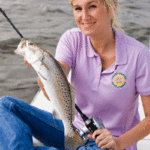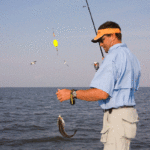
The large diversion has forced Lafitte anglers to change their trout-targeting tactics this time of year.
While telling me about how the Davis Pond Diversion has affected speckled trout fishing around Lafitte, Capt. Theophile Bourgeois mentioned something that I don’t think he realized provided a perfect contrast of the life before and after the levee break started flowing.
When he was a kid, the area known as The Pen was small. Now, it’s a monster. Chalk up this increased size of The Pen to coastal erosion.
Up until a few years ago, all Bourgeois had to do to catch speckled trout was to make a short trip to The Pen where the salinity levels were high enough for speckled trout.
Now, he doesn’t hear anything about catching speckled trout in The Pen, and the closest place to consistently find the salinities trout need is Hackberry Bay.
Chalk up the lack of speckled trout around Lafitte to the Davis Pond Diversion.
The benefits of curtailing coastal erosion aside, whether all the fresh water around Lafitte is a good thing or bad depends on through whose eyes you look.
“It’s screwing up our speckled trout for sure,” Bourgeois said. “Keep in mind, I’m not full of a bunch of hard facts. I’m just going by what I see and what biologists tell me. What I do know is that where I used to catch redfish and speckled trout, I now catch redfish and bass.”
Being that he is primarily a redfish guide, Bourgeois added that Davis Pond has been great for redfish. The habitat is nice and healthy, and there are different species of grass growing everywhere. Bourgeois also is seeing roseau cane blooms everywhere he looks.
“There’s definitely been a change in the terrain,” he said. “And there’s a little bit of positives and negatives in everything in life. The positives with Davis Pond are it’s good for perch, bass, redfish and ducks, but the negative is that it’s bad for speckled trout, oysters and crabs.”
Capt. Jason Shilling with New Orleans Style Fishing Charters has experienced much the same as Bourgeois. Places around Lake Salvador like Jones Point, where Shilling used to load the boat with speckled trout, haven’t given up 25 trout in the last six years much less six hours.
“They dedicated Davis Pond in 2002, so that was 10 years ago,” Shilling said, “and I probably haven’t caught a trout out of Lake Salvador since 2006. So that’s at least six years that I haven’t caught a trout there. That’s not to say trout won’t go in low-salinity water, but they’re not going to stay if the salinity isn’t right.”
What has happened since the opening of the Davis Pond Diversion is that the fresh water diverted from the Mississippi River flows first through Lake Cataouatche where it filters through the expansive grass flats.
Then all this fresh water flows through Salvador to the Intracoastal Waterway and into Bayou Perot. From there, it flows out into Little Lake and Turtle Bay through the Harvey Cut.
“All that fresh water keeps the salinity really low all the way down to the north end of Little Lake,” Shilling explained. “What we’ve got is a constant battle between Mississippi River water and Gulf of Mexico water.
“If we get strong south winds and high tide when there’s no water coming through Davis Pond, the saltwater line moves farther north. When we get water coming through Davis Pond with a strong north wind and low tide, that moves the saltwater line farther south.”
But generally speaking nowadays, this saltwater line is going to stay a lot farther south than what it used to. Whereas Bourgeois and Shilling used to catch trout right there in Bayou Rigolets and Bayou Perot, they now have to go at least to the south side of Little Lake if not even farther.
“Your starting point used to be two miles away — now it’s 15 miles,” Bourgeois said. “And then you’ve got to work south from there. That fresh water isn’t confined to its direct route either. It spreads out to the east and west, pushing the salt line farther south, which means it’s pushing the speckled trout farther south, too.”
So how do speckled trout anglers know they’ve gone south far enough? According to Shilling, there are a few visible signs to look for. One is diving birds, and the other is a foamy prop wash.
As you motor through fresh water, your prop wash tends to be a lot of bubbles that disappear rather quickly. On the other hand, when you hit the salt water, your prop wash will become foamy and stick around for a long ways behind your boat.
“If you’ve got foamy prop wash, you’ve probably got enough salinity to consistently catch speckled trout,” Shilling said. “Other than that, the only other way to know is to stick your finger in the water and taste it.”
Although finding clear water would lead one to believe they have stumbled upon water salty enough to hold trout, Bourgeois said that isn’t always the case. Muddy fresh water can obviously push south, but salt water can muddy up just as quickly when the wind starts blowing.
“The mud that you see isn’t always from Davis Pond,” Bourgeois said. “The grass in Cataouatche filters a lot of the mud out anyway. But most of the muddy water you see fishing south of Lafitte is from wind and the openness of the area, which has come from coastal erosion. That’s the big gray area with the diversion. We sacrifice crabs, oysters and trout, but we get better vegetation in there to fight losing our land.”
However, there is one case in particular where Shilling has seen the diversion push up mud swells in the north end of Little Lake. When diversion water is flowing through the Harvey Cut, Temple and the Short Cut, you see current flowing through there that pushes up mud in Little Lake. Shilling didn’t believe any natural current would do that.
One place where Shilling has found some consistently good speckled trout fishing so far this year is in a nearly walled off area known as Brusle Lake all the way on the south end of Little Lake just south of Bay L’Ours.
“It’s surrounded by rocks, and there’s one opening on the west end that you can get through,” Shilling explained. “It stays clean in there, and I’ve been pretty impressed with some of the limits I’ve caught and what a few buddies have been able to do in there.”
Although it’s just on the other side of Bay L’Ours, Shilling went on to explain that the salt line must have been somewhere between Brusle Lake and the north end of Little Lake because it was obviously salty enough in Brusle for the trout while the north end of Little Lake had very low salinity.
Shilling also feels that the kind of winter we get in South Louisiana has a lot to do with trout fishing the following spring. We experienced a cold winter two years ago, but this past winter was unseasonably warm.
“We actually caught a few trout in The Pen back in early February,” Shilling said. “I guess when the river is low and they’re not pumping, the salinity in there can creep up a little bit. But it wasn’t much to get excited about. We only caught a few, and we haven’t caught them in there since.”
The simple fact of the matter is that when the Davis Pond diversion is pumping out its nearly 11,000 cubic feet of water per second at the top of a saltwater estuary, all that water is going to go through that estuary’s network of bays, bayous and lakes.
As it filters though, it pushes fresh water in on top of Lafitte and changes the salinity, the vegetation and the fish. Take the islands between Bayous Perot and Rigolets for instance. Shilling used to catch a lot of trout around those islands. Now he catches a lot of bass.
“You take the salt out of a saltwater estuary, and it’s going to kill all the saltwater plants,” Shilling said. “When they’re pumping that kind of fresh water through here from the Mississippi River, you can’t help but have freshwater plants and fish take the place of saltwater plants and fish.”
Since speckled trout are the first saltwater fish to be replaced when the fresh water moves in, the picture isn’t quite so rosy if you see things through their yellow eyes.
Contact Capt. Theophile Bourgeois at 504-341-5614 and Capt. Jason Shilling at 504-416-5896.






